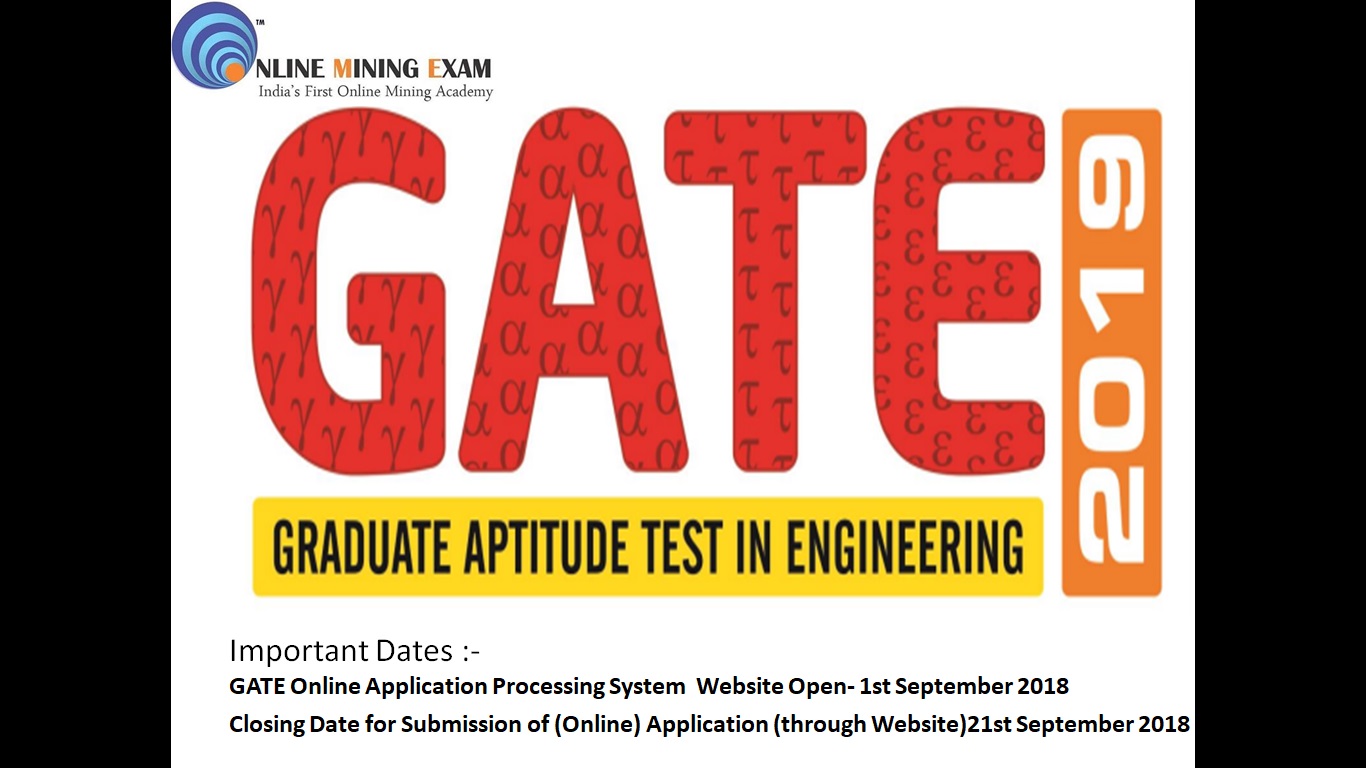
Gate Notification 2019
Introduction
Graduate Aptitude Test in Engineering (GATE) is an examination conducted jointly by the Indian Institute of Science (IISc), Bangalore and the seven Indian Institutes of Technology (at Bombay, Delhi, Guwahati, Kanpur, Kharagpur, Madras and Roorkee) on behalf of the National Coordination Board (NCB)-GATE, Department of Higher Education, Ministry of Human Resource Development (MHRD), Government of India.
Qualifying in GATE is a mandatory requirement for seeking admission and/or financial assistance to: (i) Master’s programs and direct Doctoral programs in Engineering/Technology/Architecture and (ii) Doctoral programs in relevant branches of Science, in the institutions supported by the MHRD and other Government agencies. Even in some colleges and institutions, which admit students without MHRD scholarship/assistantship, the GATE qualification is mandatory. Further, many Public Sector Undertakings (PSUs) have been using the GATE score in their recruitment process.
Use of GATE score for Employment
In the past, several Public Sector Undertakings (PSUs) have used GATE scores to shortlist the candidates for employment. A few such organizations are: Bharat Heavy Electricals Limited (BHEL), Gas Authority of India Limited (GAIL), Hindustan Aeronautics Limited (HAL), Indian Oil Corporation Limited (IOCL), National Thermal Power Corporation (NTPC), Nuclear PowerCorporation of India Limited (NPCIL), Oil and Natural Gas Corporation (ONGC) and Power Grid Corporation of India (PGCI).
Direct recruitment to Group A level posts in Central government, i.e., Senior Field Officer (Tele), Senior Research Officer (Crypto) and Senior Research Officer (S&T) in Cabinet Secretariat, Government of India, is now being carried out on the basis of GATE score. The details of the scheme of recruitment are normally published in National Newspapers/Employment News/Rozgar Samachar by the concerned authority.
Some other Government of India Organizations have also expressed their interest to utilize GATE 2019 score for their recruitment purpose.
Note: GATE administration is not responsible for employment opportunities. The qualified candidates must check newspapers and other reliable sources for any such information.
Syllabus
Section 1: Engineering Mathematics
Linear Algebra: Matrices and Determinants; Systems of linear equations; Eigen values and Eigen vectors.
Calculus: Limit, continuity and differentiability; Partial Derivatives; Maxima and minima; Sequences and series; Test for convergence; Fourier series.
Vector Calculus: Gradient; Divergence and Curl; Line; surface and volume integrals; Stokes, Gauss and Green’s theorems.
Diferential Equations: Linear and non-linear first order ODEs; Higher order linear ODEs with constant coefficients; Cauchy’s and Euler’s equations.
Probability and Statistics: Measures of central tendency; Random variables; Poisson, normal and binomial distributions; Correlation and regression analysis.
Numerical Methods: Solutions of linear algebraic equations; Integration of trapezoidal and Simpson’s rule; Single and multi-step methods for differential equations.
Section 2: Mine Development and Surveying
Mine Development: Methods of access to deposits; Underground drivages; Drilling methods and machines; Explosives, blasting devices and practices.
Mine Surveying: Levels and leveling, theodolite, tacheometry, triangulation; Contouring; Errors and adjustments; Correlation; Underground surveying; Curves; Photogrammetry; Field astronomy; EDM and Total Station; Introductory GPS .
Section 3: Geomechanics and Ground Control
Engineering Mechanics: Equivalent force systems; Equations of equilibrium; Two dimensional frames and trusses; Free body diagrams; Friction forces; Particle kinematics and dynamics; Beam analysis.
Geomechanics: Geo-technical properties of rocks; Rock mass classification; Instrumentation and stress measurement techniques; Theories of rock failure; Ground vibrations; Stress distribution around mine openings; Subsidence; Rock bursts and coal bumps; Slope stability.
Ground Control: Design of pillars; Roof supporting systems; Mine filling.
Section 4: Mining Methods and Machinery
Mining Methods: Surface mining: layout, development, loading, transportation and mechanization, continuous surface mining systems; Underground coal mining: bord and pillar systems, room and pillar mining, longwall mining, thick seam mining methods; highwall mining; Underground metal mining: open, supported and caved stoping methods, stope mechanization, ore handling systems.
Mining Machinery: Generation and transmission of mechanical, hydraulic and pneumatic power; Materials handling: haulages, conveyors, face and development machinery, hoisting systems, pumps, crushers.
Section 5: Surface Environment, Mine Ventilation, and Underground Hazards
Surface Environment: Air, water and soil pollution : Standards of quality, causes and dispersion of contamination, and control; Noise; Land reclamation.
Mine Ventilation: Underground atmosphere; Heat load sources and thermal environment, air cooling; Mechanics of air flow, distribution, natural and mechanical ventilation; Mine fans and their usage; Auxiliary ventilation; Ventilation planning; Ventilation networks.
Subsurface Hazards: Mine Gases. Underground hazards from fires, explosions, dust and inundation; Rescue apparatus and practices; Safety in mines; Accident data analysis; Mine lighting; Mine legislation; Occupational safety.
Section 6: Mine Economics, Mine Planning, Systems Engineering
Mine Economics: Mineral resource classification; Discounted cash flow analysis; Mine valuation; Mine investment analysis; Mineral taxation.
Mine Planning: Sampling methods, practices and interpretation; Reserve estimation techniques: Basics of geostatistics and quality control; Optimization of facility location; Work-study.
Systems Engineering: Concepts of reliability; Reliability of simple systems; Maintainability and availability; Linear programming, transportation and assignment problems; Network analysis; Inventory models; Queueing theory; Basics of simulation.
Section 5: Surface Environment, Mine Ventilation, and Underground Hazards
Surface Environment: Air, water and soil pollution : Standards of quality, causes and dispersion of contamination, and control; Noise; Land reclamation.
Mine Ventilation: Underground atmosphere; Heat load sources and thermal environment, air cooling; Mechanics of air flow, distribution, natural and mechanical ventilation; Mine fans and their usage; Auxiliary ventilation; Ventilation planning; Ventilation networks.
Subsurface Hazards: Mine Gases. Underground hazards from fires, explosions, dust and inundation; Rescue apparatus and practices; Safety in mines; Accident data analysis; Mine lighting; Mine legislation; Occupational safety.
Section 6: Mine Economics, Mine Planning, Systems Engineering
Mine Economics: Mineral resource classification; Discounted cash flow analysis; Mine valuation; Mine investment analysis; Mineral taxation.
Mine Planning: Sampling methods, practices and interpretation; Reserve estimation techniques: Basics of geostatistics and quality control; Optimization of facility location; Work-study.
Systems Engineering: Concepts of reliability; Reliability of simple systems; Maintainability and availability; Linear programming, transportation and assignment problems; Network analysis; Inventory models; Queueing theory; Basics of simulation.









Comments